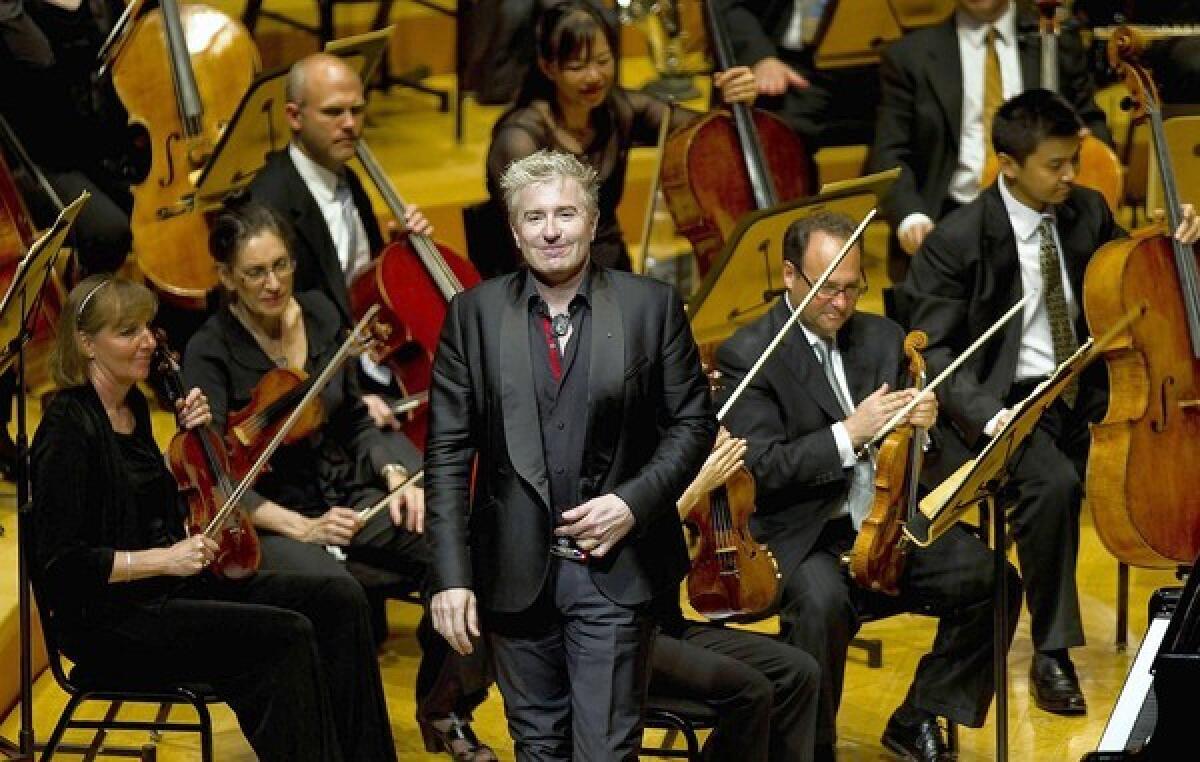Lionel Bringuier ends L.A. Philharmonic stint on a high note

- Share via
The Los Angeles Philharmonic sent Lionel Bringuier out into the world on Sunday afternoon. Lucky world.
And lucky Zurich, where the streets in Switzerland’s posh financial capital are already paved with gold and which will have the 26-year-old French conductor next year as music director of its Tonhalle Orchestra.
If the L.A. Phil likes to think of itself as a family — and not in the dysfunctional sense so common in the symphonic world — then Bringuier was its baby. At 20, he became the orchestra’s youngest assistant conductor ever.
PHOTOS: Arts and culture in pictures by The Times
Six years later, as L.A. Phil resident conductor, sought the world over as a guest conductor, Bringuier ended his formal L.A. Phil relationship with a resplendent matinee of vivid French music in Walt Disney Concert Hall.
Sober orchestra players practically beamed. The soloist, Jean-Yves Thibaudet — his silver Porsche convertible hard to miss in the garage with the proud vanity plate PIANO JY — seemed intent to take Bringuier on a joy ride to remember as the popular French pianist brilliantly dashed through Saint-Saëns’ Fifth Piano Concerto. L.A. patrons, demonstratively unhappy the previous week when their subscription series was turned over to young Brooklyn composers who clearly failed in their efforts to please, were demonstratively happy this week.
Bringuier doesn’t have, at least yet, an altogether distinctive sound or style. He’s picked up pointers from working with Esa-Pekka Salonen and Gustavo Dudamel. He exhibits the former’s straightforward stick technique and attraction to clarity. He has the latter’s love for getting absorbed in opulent sonorities. His own contribution is, especially in color-drenched French scores like those on the weekend’s program, to act like an adroit chef who eagerly extracts maximum flavor while retaining absolute freshness. He is, after all, French.
Bringuier began Sunday with Messiaen’s first orchestral work, “Les Offrandes Oubliées.” The title translates as “The Forgotten Offerings,” and that is exactly what the work is. Written in 1930 when Messiaen was 22 and just out of conservatory, the 12-minute score is understandably overlooked, what with so much other more extravagant Messiaen orchestral music to chose from.
But “Offrandes Oubliées” is fascinating in that it is already full of the mystical Catholic material that would hold the composer’s attention throughout his life. It also already presages the shimmering mysterious sonorities that helped define the Messiaen sound.
Those sonorities pervaded Disney like sonic perfume. Bringuier has the distinction of being the first conductor to have matured in the hall’s uniquely enthralling acoustics, and that is likely to have a lasting effect on him. He simply let Messiaen’s sound flower, and that fragrance was the reward.
CHEAT SHEET: Spring Arts Preview
My own revelation Sunday was that Saint-Saëns’ glittery Fifth Piano Concerto, known as the “Egyptian” because of a modicum of orientalism in the slow movement, isn’t as utterly ridiculous as I had previously believed. Thibaudet is mainly to be thanked for that.
The French pianist is never shy when it comes to glitter. He’s usually wearing something sparkly as well as driving something sparkly. I doubt that he would be hard to miss tootling around town with the top down.
But what made all the difference was just how fast he went through the “Egyptian” landscape. Saint-Saëns’ well-worn tunes are of earworm caliber. There may even be sophistication in some of the music’s simplicity, as long as you don’t dwell on it. Thibaudet didn’t. He showed instead where to find the glamour in the first movement. He brought a sense of style to the slow movement. And he was not afraid to have fun racing like the dickens through the Finale. Bringuier was a willing accomplice.
Color kept coming. In the program’s second half, Bringuier, as they say, reveled in Ravel, irresistibly so in the “Daphnis and Chloé” Suite No. 2 and “La Valse.” The suite begins with a sunrise as languid lovers awake and the forest comes to life. Bringuier carefully let the details emerge. He also loves a good swell and loud climaxes, and the L.A. Phil, at its thick and lush best, let him have what he loves. The ecstatic final dance had an energy more often found in a frenzied, amplified dance club than a philharmonic society.
“La Valse” was, to quote a clever audience member, Bringuier’s last dance. This is Ravel’s extraordinary depiction of a Vienna ball getting out of hand. Bringuier began by dramatically underscoring dark orchestral undercurrents that infect the waltz. But his spirits were high. He ended in a blaze.
He hasn’t, however, waltzed out of the L.A. Phil family for good. Bringuier will be back in Disney as a guest conductor next season, and neither the orchestra nor the audience needs encouragement from me to insist that he return to his former home for regular visits. This is one family’s clutch from which he’s not going to easily escape.
More to Read
The biggest entertainment stories
Get our big stories about Hollywood, film, television, music, arts, culture and more right in your inbox as soon as they publish.
You may occasionally receive promotional content from the Los Angeles Times.











